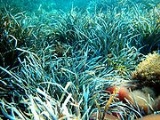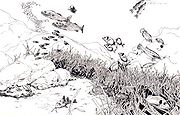
Posidonia oceanica
Encyclopedia
Posidonia oceanica is a seagrass
species that is endemic to the Mediterranean Sea
. It forms large underwater meadows that are an important part of the ecosystem. The fruit is free floating and known in Italy
as 'the olive of the sea' (l'oliva di mare). Balls of fibrous material from its foliage, known as egagropili, wash up to nearby shorelines.
 P. oceanica is a flowering plant
P. oceanica is a flowering plant
which lives in dense meadows or along channels in the sands of the Mediterranean. It is found at depths from 1–35 m (3.3–114.8 ft), according to water clarity. Subsurface rhizome
s and root
s stabilize the plant while erect rhizomes and leaves reduce silt
accumulation.
The leaves are ribbon-like, appearing in tufts of 6 or 7, and up to 1.5 metres (4.9 ft) long. Average leaf width is around 10 millimetre (0.393700787401575 in). The leaves are bright green, perhaps turning brown with age, and have 13 to 17 parallel veins. The leaf terminus is rounded or sometimes absent because of damage. Leaves are arranged in groups, with older leaves on the outside, longer and differing in form from the younger leaves they surround.
The rhizome type stems are found in two forms: one growing up to 150 centimetres (59.1 in) beneath the sand and the other rising above the sand. All stems are approximately 10 millimetre (0.393700787401575 in) thick and upright in habit. This arrangement of the rhizomes eventually forms a mat; the surface contains the active parts of the plant, whereas the center is a dense network of roots and decomposing stems.
The flowering plant's common name is Neptune grass. In 2006 a huge clonal colony
of P. oceanica was discovered south of the island of Ibiza
. At 8 kilometres (5 mi) across and possibly up to 100,000 years of age, it may be one of the largest and oldest clonal colonies on Earth.
 This species is found only in the Mediterranean Sea where it is in decline, occupying an area of only about 3% of the basin. This corresponds to a surface area of about 38000 square kilometres (14,671.9 sq mi). Posidonia grows best in clean waters, and its presence is a marker for lack of pollution. The presence of Posidonia can be detected by the masses of decomposing leaves on beaches. Such plant material has been used for composting, but Italian laws prohibit the use of marine algae
This species is found only in the Mediterranean Sea where it is in decline, occupying an area of only about 3% of the basin. This corresponds to a surface area of about 38000 square kilometres (14,671.9 sq mi). Posidonia grows best in clean waters, and its presence is a marker for lack of pollution. The presence of Posidonia can be detected by the masses of decomposing leaves on beaches. Such plant material has been used for composting, but Italian laws prohibit the use of marine algae
and plants for this purpose.
, the Greek
god of the seas, while oceanica refers to its former wide distribution. Carl Linnaeus gave the first botanical description of this species in Systema Naturae
, although the genus was then named Zostera. The APG system
(1998) and APG II system
(2003) accept the genus as constituting the sole genus in the family Posidoniaceae, which it places in the order Alismatales
, in the clade monocots. The Angiosperm Phylogeny Website concludes that the three families Cymodoceaceae, Posidoniaceae and Ruppiaceae
form a monophyletic group. Earlier systems classified this genus in the family Potamogetonaceae
or in the family Posidoniaceae but belonging to order Zosterales.
Seagrass
Seagrasses are flowering plants from one of four plant families , all in the order Alismatales , which grow in marine, fully saline environments.-Ecology:...
species that is endemic to the Mediterranean Sea
Mediterranean Sea
The Mediterranean Sea is a sea connected to the Atlantic Ocean surrounded by the Mediterranean region and almost completely enclosed by land: on the north by Anatolia and Europe, on the south by North Africa, and on the east by the Levant...
. It forms large underwater meadows that are an important part of the ecosystem. The fruit is free floating and known in Italy
Italy
Italy , officially the Italian Republic languages]] under the European Charter for Regional or Minority Languages. In each of these, Italy's official name is as follows:;;;;;;;;), is a unitary parliamentary republic in South-Central Europe. To the north it borders France, Switzerland, Austria and...
as 'the olive of the sea' (l'oliva di mare). Balls of fibrous material from its foliage, known as egagropili, wash up to nearby shorelines.
Description

Flowering plant
The flowering plants , also known as Angiospermae or Magnoliophyta, are the most diverse group of land plants. Angiosperms are seed-producing plants like the gymnosperms and can be distinguished from the gymnosperms by a series of synapomorphies...
which lives in dense meadows or along channels in the sands of the Mediterranean. It is found at depths from 1–35 m (3.3–114.8 ft), according to water clarity. Subsurface rhizome
Rhizome
In botany and dendrology, a rhizome is a characteristically horizontal stem of a plant that is usually found underground, often sending out roots and shoots from its nodes...
s and root
Root
In vascular plants, the root is the organ of a plant that typically lies below the surface of the soil. This is not always the case, however, since a root can also be aerial or aerating . Furthermore, a stem normally occurring below ground is not exceptional either...
s stabilize the plant while erect rhizomes and leaves reduce silt
Silt
Silt is granular material of a size somewhere between sand and clay whose mineral origin is quartz and feldspar. Silt may occur as a soil or as suspended sediment in a surface water body...
accumulation.
The leaves are ribbon-like, appearing in tufts of 6 or 7, and up to 1.5 metres (4.9 ft) long. Average leaf width is around 10 millimetre (0.393700787401575 in). The leaves are bright green, perhaps turning brown with age, and have 13 to 17 parallel veins. The leaf terminus is rounded or sometimes absent because of damage. Leaves are arranged in groups, with older leaves on the outside, longer and differing in form from the younger leaves they surround.
The rhizome type stems are found in two forms: one growing up to 150 centimetres (59.1 in) beneath the sand and the other rising above the sand. All stems are approximately 10 millimetre (0.393700787401575 in) thick and upright in habit. This arrangement of the rhizomes eventually forms a mat; the surface contains the active parts of the plant, whereas the center is a dense network of roots and decomposing stems.
The flowering plant's common name is Neptune grass. In 2006 a huge clonal colony
Clonal colony
A clonal colony or genet is a group of genetically identical individuals that have grown in a given location, all originating vegetatively from a single ancestor. In plants, an individual in such a population is referred to as a ramet...
of P. oceanica was discovered south of the island of Ibiza
Ibiza
Ibiza or Eivissa is a Spanish island in the Mediterranean Sea 79 km off the coast of the city of Valencia in Spain. It is the third largest of the Balearic Islands, an autonomous community of Spain. With Formentera, it is one of the two Pine Islands or Pityuses. Its largest cities are Ibiza...
. At 8 kilometres (5 mi) across and possibly up to 100,000 years of age, it may be one of the largest and oldest clonal colonies on Earth.
Range and habitat

Algae
Algae are a large and diverse group of simple, typically autotrophic organisms, ranging from unicellular to multicellular forms, such as the giant kelps that grow to 65 meters in length. They are photosynthetic like plants, and "simple" because their tissues are not organized into the many...
and plants for this purpose.
Taxonomy
The genus Posidonia is named after PoseidonPoseidon
Poseidon was the god of the sea, and, as "Earth-Shaker," of the earthquakes in Greek mythology. The name of the sea-god Nethuns in Etruscan was adopted in Latin for Neptune in Roman mythology: both were sea gods analogous to Poseidon...
, the Greek
Greece
Greece , officially the Hellenic Republic , and historically Hellas or the Republic of Greece in English, is a country in southeastern Europe....
god of the seas, while oceanica refers to its former wide distribution. Carl Linnaeus gave the first botanical description of this species in Systema Naturae
Systema Naturae
The book was one of the major works of the Swedish botanist, zoologist and physician Carolus Linnaeus. The first edition was published in 1735...
, although the genus was then named Zostera. The APG system
APG system
The APG system of plant classification is the first, now obsolete, version of a modern, mostly molecular-based, system of plant taxonomy that was published in 1998 by the Angiosperm Phylogeny Group. It was superseded in 2003 by a revision, the APG II system, and then in 2009 by a further...
(1998) and APG II system
APG II system
The APG II system of plant classification is the second, now obsolete, version of a modern, mostly molecular-based, system of plant taxonomy that was published in April 2003 by the Angiosperm Phylogeny Group. It was a revision of the first APG system, published in 1998, and was superseded in 2009...
(2003) accept the genus as constituting the sole genus in the family Posidoniaceae, which it places in the order Alismatales
Alismatales
Alismatales is an order of flowering plants including about 2500 species. Pleants assigned to this order are mostly tropical or aquatic.-Description:...
, in the clade monocots. The Angiosperm Phylogeny Website concludes that the three families Cymodoceaceae, Posidoniaceae and Ruppiaceae
Ruppiaceae
Ruppia, also known as the ditch grasses, is the only genus in the family Ruppiaceae. Such a family has been recognized by relatively few taxonomists...
form a monophyletic group. Earlier systems classified this genus in the family Potamogetonaceae
Potamogetonaceae
The Potamogetonaceae, commonly referred to as the pondweed family, is an aquatic family of monocotyledonous flowering plants. There are roughly 120 species spread across six genera in the Potamagetonaceae...
or in the family Posidoniaceae but belonging to order Zosterales.
External links
- Posidoniaceae in L. Watson and M. J. Dallwitz (1992 onwards) The families of flowering plants
- National Center for Biotechnology Information
- Germplasm Resources Information Network: Posidonia
- Flora Europaea: Posidonia
- Ibiza's Monster Marine Plant. Ibiza Spotlight, 28 May 2006.

